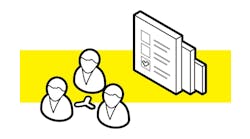How to Better Afford a Competitive Benefits Package
John Wafler knows that one of the biggest challenges facing shops is finding, attracting and retaining quality talent.
Here’s the problem: Most “quality” employees aren’t unemployed. Which means you have to offer a deal that’s at least as equal—if not better—than their current situation.
“Quality employees are typically employed somewhere else, but they could be looking for an upgrade,” Wafler says. “So you have to put together the whole package for their employment that is attractive to them.”
Wafler coaches hundreds of shops through the Bottom-Line Impact Groups at RLO Training, and he says developing a comprehensive and competitive benefits package is crucial in recruiting and retaining talent.
Putting together the actual benefits package, however, is a process unique to each shop. While standard items should appear on all benefits packages, Wafler says the process of forming a package that is more attractive than your competitors involves some non-standard opportunities that empower the employees and contribute more to your business—all while trying to make that benefits package more affordable through financial planning.
Put Together a Financial Forecast
The biggest challenge with benefits packages, Wafler says, is balancing the increasing costs of benefits with the shop’s bottom line profit. In some cases with the shops he coaches, costs have risen between 20 and 40 percent for medical insurance alone.
“Without profit, companies don’t survive and they can’t flourish and continue to offer their employees all of these benefits,” Wafler says. “So part of what we do every year is help shops put together a financial forecast and a budget for each of our members. We find that really helps them to get a bigger and broader picture what each of their expense categories can be and should be.”
Putting together a financial forecast allows a shop owner to not only map out how much the standard perks will take up from the budget, but how much would be left over for additional benefits.
Wafler provides a spreadsheet that outlines these expenses. He suggests dedicating between 2 and 4 percent of your budget to employee benefits.
“When you don’t have a forecast, you don’t have a plan,” he says. “Then every time you go to spend something, it’s like, ‘Should I or shouldn’t I?’ That can actually hurt a company and cause it to shrink rather than to grow.”
Before putting together the actual benefits package, it’s important to understand your new employee and ask crucial questions:
- Do they have a family, which will affect medical/dental coverage?
- Do they have additional costs, such as daycare, that they need help with?
- What are their goals, hobbies, or personal interests?
- Do they value their personal time more than monetary benefits?
- Are they interested in profit sharing or stock options?
“Not all employees need the same things,” Wafler says. “You have to offer it to them universally; otherwise you’d be in court for discrimination. But, based on your employees and their individual needs, you would tailor a package that fits them.”
Medical Plans
While medical and dental plans have become commonplace for benefits packages, Wafler sees costs rising with many shops, which requires due diligence from shop owners to keep costs down.
“The idea is to try and keep control of this expense category and not let it get out of hand,” Wafler says. “Each employee shares in their benefits package. Usually it will be some sort of split, 50/50, 60/40. It depends on the shop, the level of profitability and the individual employees, which is all part of the forecast.”
If the employee wants the medical plan to cover his or her family as well, Wafler suggests the employees absorb the costs for family members, since the costs become less predictable and controllable. He also suggests a cap of somewhere between $250 and $500 per month per employee to ensure you can control expenses.
Whether it be through the Affordable Care Act, an automotive association or a localized plan, finding the most cost-efficient health plan is a process. Wafler suggests internally reviewing your health plan and its costs every year, and shopping your insurance and receiving comparative quotes every two years.
“You should say, ‘Come in, analyze my needs, and make your suggestions as to what you think I need and what it would cost me,’” he says. “That way you’re making sure that it’s not just the cost of the package—it’s the overall bang for your buck, the best plan and the best value for your money.”
Wafler says some shops include disability plans, but it can be very expensive and very few of his clients include disability in their plans.
“I guess if you’re a gambler you take that risk,” he says. “It’s for the employee’s benefit primarily. But I don’t think I would include that in my budget as far as the primary plan goes.”
Paid Time Off and Sick Days
Wafler says paid time off should increase each year somebody is employed, but, in most cases, it should cap at two weeks and include a set amount of statutory days.
“The paid time off should only increase up to a certain point,” he says. “I think the pay and compensation to the employees should increase versus just continuing to give them more paid time off.”
However, Wafler says many employees value their time off more than monetary benefits, which makes paid time off all the more attractive to some potential talent.
“If an employee isn’t as motivated by money as they would be by time off, you can offer them additional time off in lieu of additional pay in some cases,” he says. “That way you’re not discriminating—you’re just tailoring the individual plan to suit their needs. So being flexible as an employer is key.”
Sick days, on the other hand, are an issue Wafler says employers should be stricter about.
“Essentially you’re encouraging people to be sick and take those days,” he says. “So instead of that, we suggest you offer a wellness bonus.”
As an example, Wafler suggests setting a wellness bonus of $500. If an employer doesn’t miss a single day of work outside paid time off, he or she would receive the entire bonus. For each day an employee misses, the bonus would decrease.
“So they’re being encouraged to stay and be productive, rather than to go home and get paid and you lose that productivity,” he says.
Profit Sharing and Financial Assistance
In the latest round of meetings with his shop owners, Wafler says a new popular facet of benefits package came up during discussion: Offering profit sharing options.
The impetus of the discussion? Eliminating the stress of year-end bonuses.
“‘How do you guys decide to give your employees at Christmas time?’” Wafler asked at the meeting. “And they said, ‘Well it doesn’t matter what we give them, it never seems to be enough.’ It’s pretty emotional, because you’re feeling pressured that time of year to give the bonus people expect.”
What Wafler suggests instead is attaching some specific performance-based criteria to the year-end bonus. Throughout the year, that bonus would increase or decrease based on the profitability of the business.
Not only does it motivate employees to earn the company more money, but encourages teamwork amongst them and improves shop morale. It’s also easier to find the money, since you’re eliminating the year-end bonus.
“The good thing is if the company does well, then it’ll probably be more than what they typically would get or expect,” Wafler says. “And they’ll really understand how they got there because it is shared with them throughout the year.
“The top employees work best when they know their performance relates directly to their compensation and ultimately to their benefits package.”
Offering profit sharing bonuses shows an employer cares about his employees’ personal finances. Wafler says you can take that further by offering financial planning training and education opportunities.
“The profit sharing, the benefits package, all of that becomes meaningless if the employees are destitute and broke because they can’t handle their finances,” he says.
Wafler suggests that shops offer personal financial planners to each employee, provide educational books and training materials, and even send them to seminars if the budget allows. When their personal finances are in order, they’re more likely to be focused at work and contribute to the shop’s overall success.
Presenting the Benefits Package
Once all the information for a benefits package has been compiled, translating it to a readable and presentable format is the final step and crucial for recruiting new employees. To do so, you should develop an employee handbook that details each benefit you offer and provide it to the employee once hired.
Wafler says a probation period is standard. There is usually 30 to 60 days before an employee starts earning his or her benefits. An employer should wait this long before making any adjustments or modifications to the package, which should be based primarily on the level of the employee’s performance.
“You really want to make sure you’re flexible, but you want them to earn that flexibility, too,” Wafler says. “I think that’s what keeps the top employees happy and keeps you with a good, productive team and crew that are pulling for you, not just pulling for themselves. They’re pulling for your company and for you as an owner and for each other as a team.”



